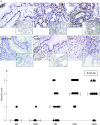Bile acids in combination with low pH induce oxidative stress and oxidative DNA damage: relevance to the pathogenesis of Barrett's oesophagus
- PMID: 17145738
- PMCID: PMC1954874
- DOI: 10.1136/gut.2006.103697
Bile acids in combination with low pH induce oxidative stress and oxidative DNA damage: relevance to the pathogenesis of Barrett's oesophagus
Abstract
Background: Barrett's oesophagus is a premalignant condition associated with an increased risk for the development of oesophageal adenocarcinoma (ADCA). Previous studies indicated that oxidative damage contributes to the development of ADCA.
Objective: To test the hypothesis that bile acids and gastric acid, two components of refluxate, can induce oxidative stress and oxidative DNA damage.
Methods: Oxidative stress was evaluated by staining Barrett's oesophagus tissues with different degrees of dysplasia with 8-hydroxy-deoxyguanosine (8-OH-dG) antibody. The levels of 8-OH-dG were also evaluated ex vivo in Barrett's oesophagus tissues incubated for 10 min with control medium and medium acidified to pH 4 and supplemented with 0.5 mM bile acid cocktail. Furthermore, three oesophageal cell lines (Seg-1 cells, Barrett's oesophagus cells and HET-1A cells) were exposed to control media, media containing 0.1 mM bile acid cocktail, media acidified to pH 4, and media at pH 4 supplemented with 0.1 mM bile acid cocktail, and evaluated for induction of reactive oxygen species (ROS).
Results: Immunohistochemical analysis showed that 8-OH-dG is formed mainly in the epithelial cells in dysplastic Barrett's oesophagus. Importantly, incubation of Barrett's oesophagus tissues with the combination of bile acid cocktail and acid leads to increased formation of 8-OH-dG. An increase in ROS in oesophageal cells was detected after exposure to pH 4 and bile acid cocktail.
Conclusions: Oxidative stress and oxidative DNA damage can be induced in oesophageal tissues and cells by short exposures to bile acids and low pH. These alterations may underlie the development of Barrett's oesophagus and tumour progression.
Conflict of interest statement
Competing interests: None declared.
Similar articles
-
Activation of the interleukin-6/STAT3 antiapoptotic pathway in esophageal cells by bile acids and low pH: relevance to barrett's esophagus.Clin Cancer Res. 2007 Sep 15;13(18 Pt 1):5305-13. doi: 10.1158/1078-0432.CCR-07-0483. Clin Cancer Res. 2007. PMID: 17875759
-
A novel mechanism of acid and bile acid-induced DNA damage involving Na+/H+ exchanger: implication for Barrett's oesophagus.Gut. 2010 Dec;59(12):1606-16. doi: 10.1136/gut.2010.213686. Epub 2010 Sep 28. Gut. 2010. PMID: 20876775 Free PMC article.
-
Protective effects of glycoursodeoxycholic acid in Barrett's esophagus cells.Dis Esophagus. 2010 Feb;23(2):83-93. doi: 10.1111/j.1442-2050.2009.00993.x. Epub 2009 Jun 22. Dis Esophagus. 2010. PMID: 19549210
-
Bile acids and Barrett's oesophagus: a sine qua non or coincidence?Scand J Gastroenterol Suppl. 2006;(243):11-7. doi: 10.1080/00365520600664219. Scand J Gastroenterol Suppl. 2006. PMID: 16782617 Review.
-
Systematic review: the role of bile acids in the pathogenesis of gastro-oesophageal reflux disease and related neoplasia.Aliment Pharmacol Ther. 2011 Jul;34(2):146-65. doi: 10.1111/j.1365-2036.2011.04709.x. Epub 2011 May 25. Aliment Pharmacol Ther. 2011. PMID: 21615439
Cited by
-
Functional and genetic determinants of mutation rate variability in regulatory elements of cancer genomes.Genome Biol. 2021 May 3;22(1):133. doi: 10.1186/s13059-021-02318-x. Genome Biol. 2021. PMID: 33941236 Free PMC article.
-
Barrett esophagus: an update.Nat Rev Gastroenterol Hepatol. 2010 Jul;7(7):369-78. doi: 10.1038/nrgastro.2010.78. Epub 2010 Jun 1. Nat Rev Gastroenterol Hepatol. 2010. PMID: 20517288 Review.
-
Mutational signature distribution varies with DNA replication timing and strand asymmetry.Genome Biol. 2018 Sep 10;19(1):129. doi: 10.1186/s13059-018-1509-y. Genome Biol. 2018. PMID: 30201020 Free PMC article.
-
Genomic landscape of a mouse model of diffuse-type gastric adenocarcinoma.Gastric Cancer. 2022 Jan;25(1):83-95. doi: 10.1007/s10120-021-01226-0. Epub 2021 Aug 13. Gastric Cancer. 2022. PMID: 34387762 Free PMC article.
-
Association of Barrett's esophagus with Helicobacter pylori infection: a meta-analysis.Ther Adv Chronic Dis. 2022 Aug 22;13:20406223221117971. doi: 10.1177/20406223221117971. eCollection 2022. Ther Adv Chronic Dis. 2022. PMID: 36034104 Free PMC article.
References
-
- Drewitz D J, Sampliner R E, Garewal H S. The incidence of adenocarcinoma in Barrett's esophagus: a prospective study of 170 patients followed 4.8 years. Am J Gastroenterol 199792212–215. - PubMed
-
- Falk G W. Barrett's esophagus. Gastroenterology 20021221569–1591. - PubMed
-
- Devesa S S, Blot W J, Fraumeni J F., Jr Changing patterns in the incidence of esophageal and gastric carcinoma in the United States. Cancer 1998832049–2053. - PubMed
-
- DeMeester T R. Management of adenocarcinoma arising in Barrett's esophagus. Semin Thorac Cardiovasc Surg 19979290–301. - PubMed
Publication types
MeSH terms
Substances
Grants and funding
LinkOut - more resources
Full Text Sources
Other Literature Sources







